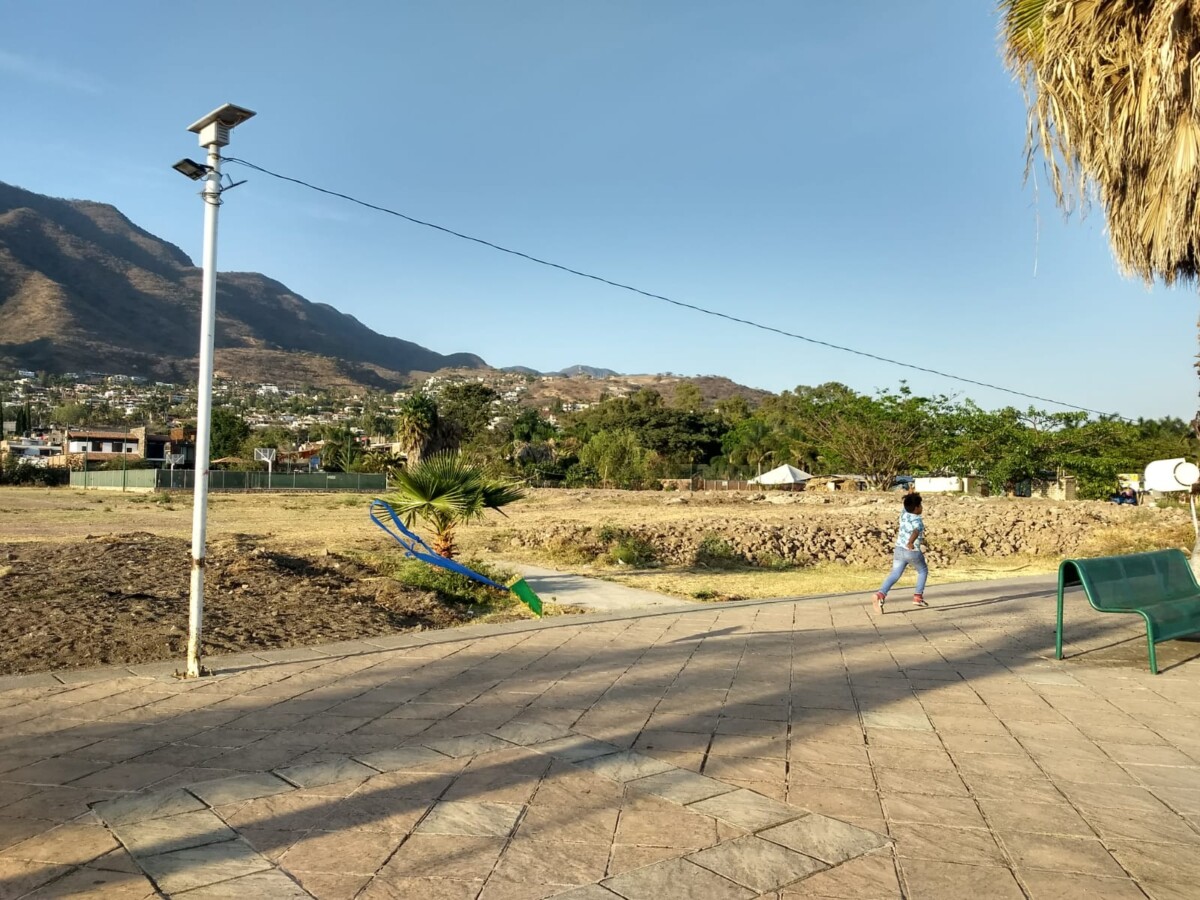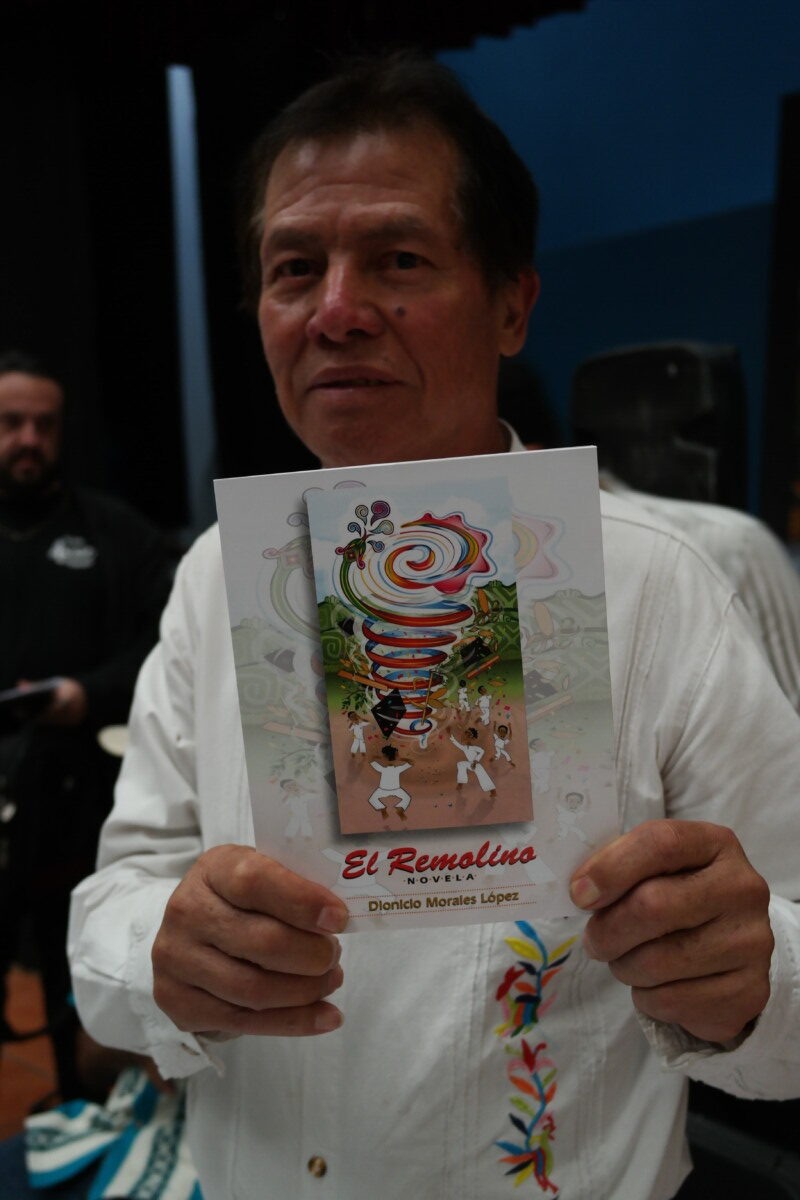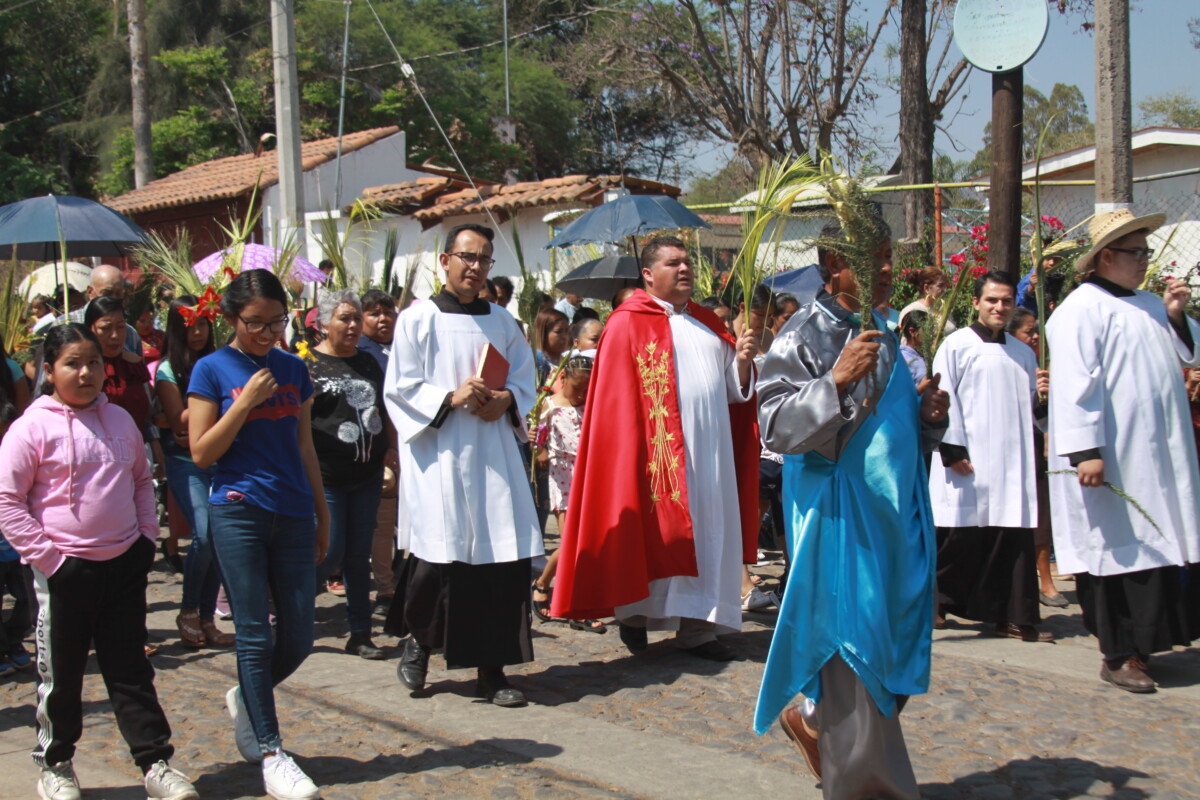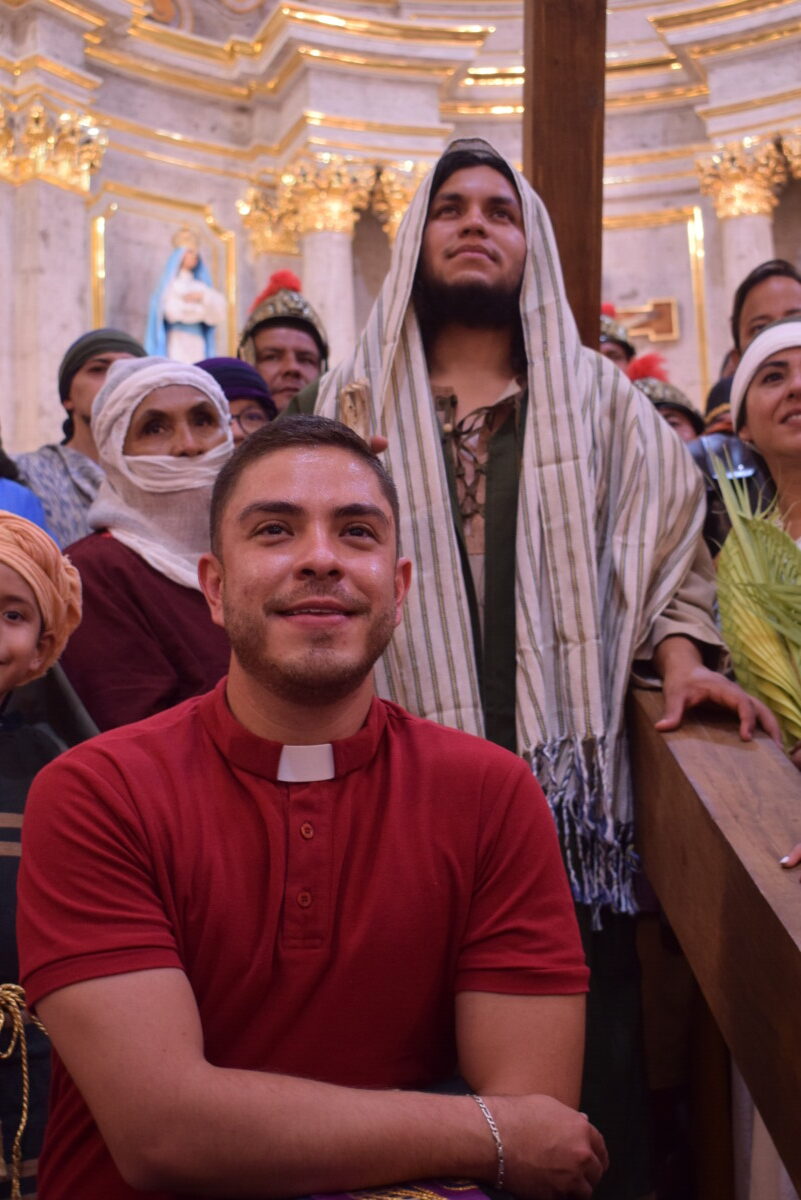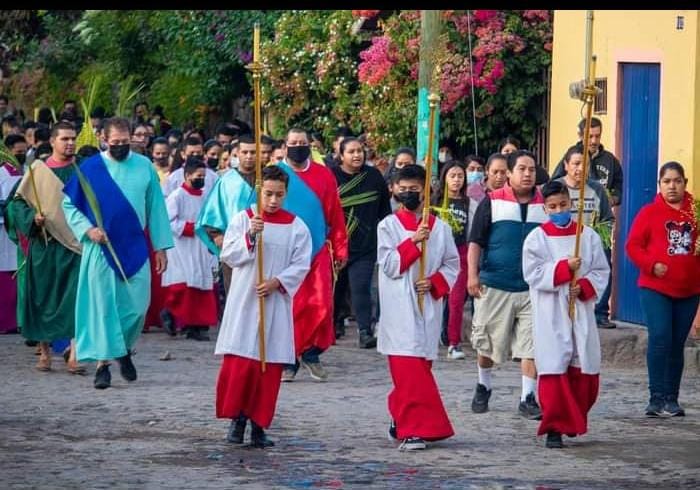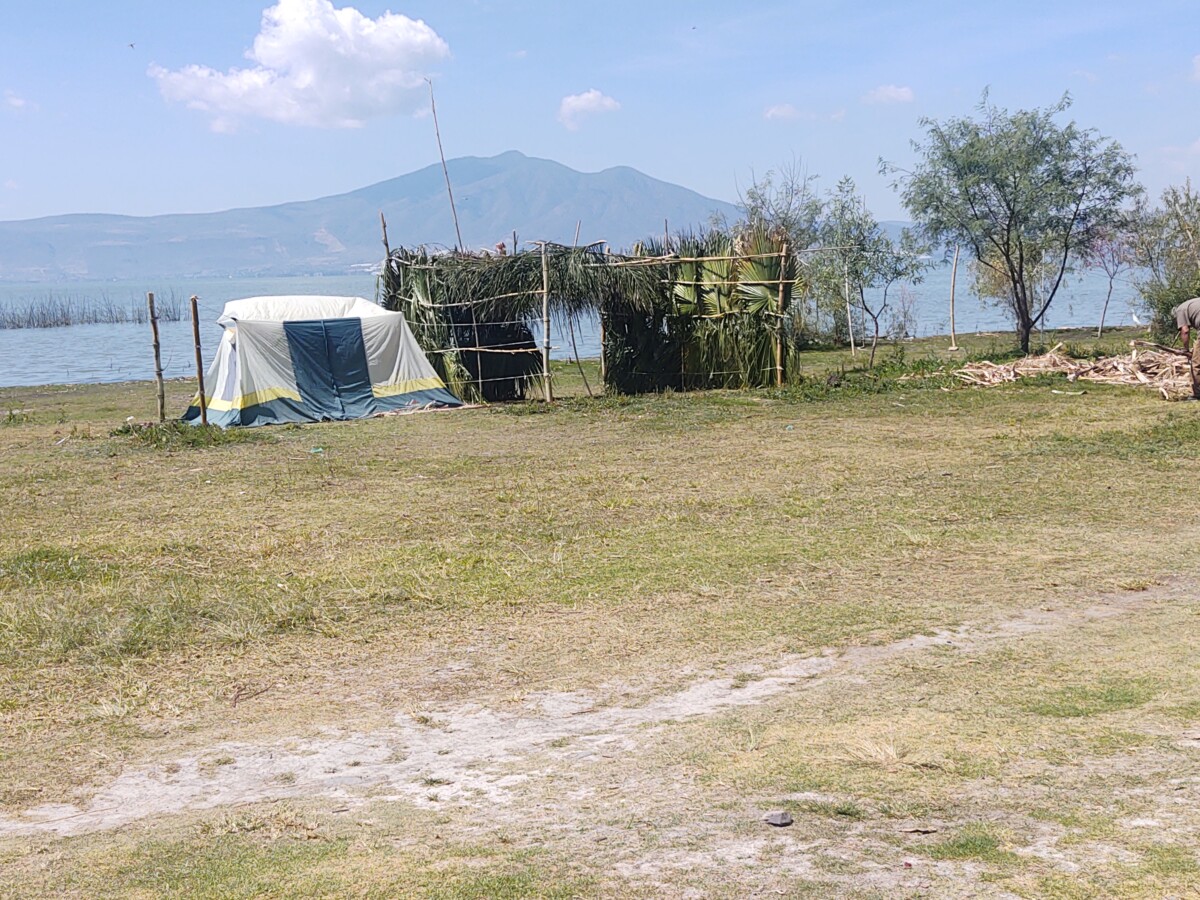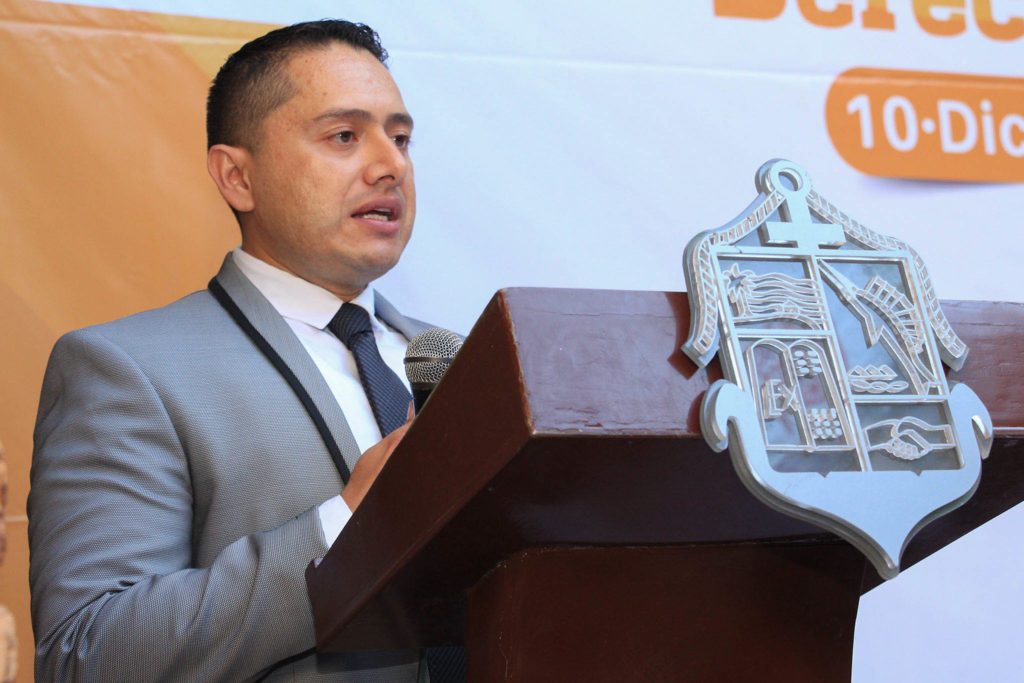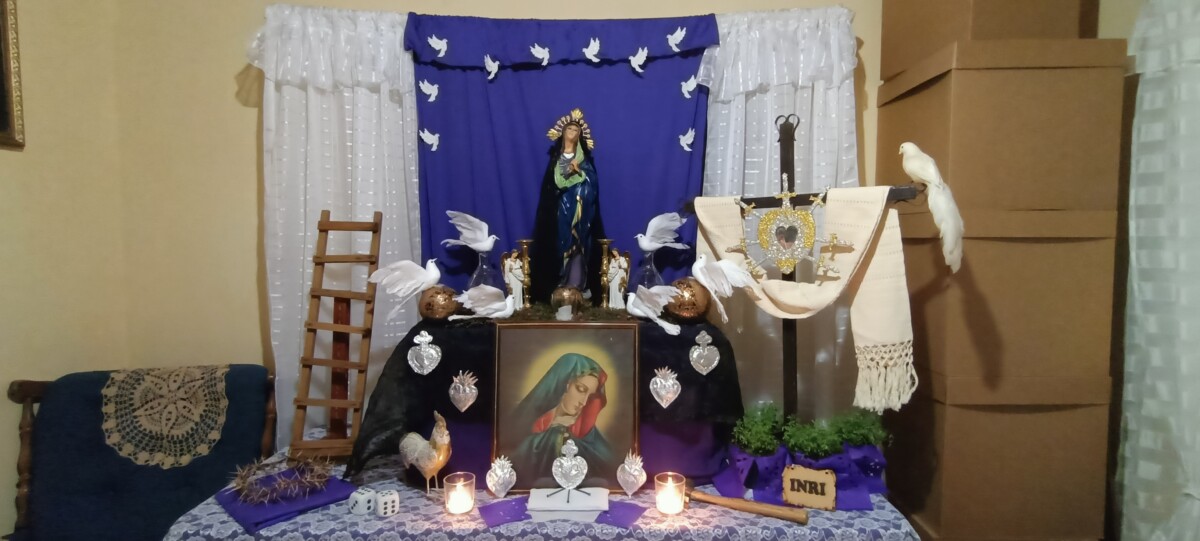gente
Con Festival del Papalote celebrarán el Día de Niño
El próximo 30 de abril, Día del Niño, se llevará a cabo en San Juan Cosalá el primer festival del Papalote, donde se espera la participación de entre 100 y 150 niños. Foto: Cortesía.
Héctor Ruiz Mejía.- Con motivo del Día del Niño, habitantes de la comunidad de San Juan Cosalá se preparan para realizar el primer Festival del Papalote.
Este evento se llevará a cabo el próximo sábado 30 de abril en el malecón de San Juan Cosalá, con el propósito de revivir la tradición de la creación de papalotes para volarlos con los vientos de primavera.
Aunque la iniciativa nació, según los organizadores, con la idea original de pintar y decorar las bancas del malecón, creando una convocatoria abierta a artistas, al final se optó por revivir la tradición de los papalotes.
Fue así que se emprendió la tarea de encontrar patrocinadores y personas de la comunidad que han apoyado el proyecto, pues aunque los materiales no son caros, “si hay un costo por más mínimo que sea”, aseguró la entrevistada.
Según la organizadora la respuesta ha sido buena y agregó que, el festival se llevará a cabo sobre el malecón a partir de las 10:00 de la mañana y se tiene contemplada una participación de entre 100 y 150 niños.
El requisito es que los infantes deben ir acompañados de al menos un adulto, pues la intención además de unir a la familia, es que apoyen a los pequeños en la construcción de su propio papalote, para después aprender a volarlo juntos.
El evento, aseguró la entrevistada, será completamente gratuito, no será necesario que los niños lleven material, pues todo lo necesario para elaborar la cometa se les brindará por parte de los organizadores.
“Aquí se les brindará todo el material, por lo que no tienen que traer nada excepto las ganas de aprender y pasar un buen rato, pues una vez que terminemos de hacer la cometa, nos iremos a volarlas a la parte del campo”, concluyó la entrevistada.
OPINIÓN: FACETAS DE MÉXICO
Ignacio Ovalle Fernández, fue secretario particular del Presidente Luis Echeverría Álvarez. Foto: Cortesía.
Por: Pascacio Taboada Cortina y Jorge Martínez Cedillo
El organismo “Seguridad Alimentaria Mexicana”, Segalmex, creada por el presidente Andrés Manuel López Obrador al inicio de su administración, apenas transcurridos tres años y meses de gestión, cambió a su director general, Ignacio Ovalle Fernández y, en su lugar, nombró a Leonel Cota Montaño, ex gobernador de Baja California Sur y actualmente secretario ejecutivo del Sistema Nacional de Seguridad Pública. Esto, frente a una corrupción incontrolable en varias delegaciones estatales y regionales. Así, Segalmex, “lejos de apoyar a campesinos de escasos recursos, desnutridos y sin apoyos crediticios, los sumió en la pobreza y desesperanza”, es el comentario de millones de afectados.
Desde el momento del nombramiento de Ignacio Ovalle Fernández, como director general de este organismo público, descentralizado de la Secretaría de Agricultura y Desarrollo Rural, con funciones similares a las que tuvo en su tiempo la Compañía Nacional de Subsistencias Populares (Conasupo) se tuvo la sensación de que continuaría la corrupción en los procesos de recepción de cosechas, comercialización de granos con aplicación de precios de garantía “castigados” por las normas de calidad estrictas.
Ignacio Ovalle Fernández, abogado de profesión, después de haber sido secretario particular del Presidente Luis Echeverría Álvarez, ocupó la titularidad de la Secretaría de la Presidencia en el mismo Gobierno. En el siguiente, a cargo de José López Portillo, fue director general de COPLAMAR. Estuvo fuera del gobierno de Miguel de la Madrid, y regresó al servicio público durante la gestión de Carlos Salinas de Gortari, como director general de Conasupo.
En todos estos años, que fueron décadas, Ovalle Fernández acumuló una amplia experiencia en el sector público, sobre todo en la selección y control de personal, como para creer que fue descuido tanto mal manejo del presupuesto en los procesos de compra y venta de granos alimenticios, fertilizantes para el trabajo de los campesinos; mercancías que utiliza la gente modesta de los pueblos y algunas ciudades pequeñas o medianas, que son tantas con millones de habitantes, que se pierde la idea de la cuantía de fraudes en casi todos los estados de la República, donde se han denunciado fraudes sin que se sepa si los culpables han sido procesados penalmente o hayan “devuelto al pueblo lo robado”.
Ignacio Ovalle Fernández, luego de su sustitución en Segalmex fue nombrado por el presidente López Obrador, como coordinador del Instituto Nacional para el Federalismo y el Desarrollo Municipal, adscrito a la Secretaría de Gobernación.
Las irregularidades en el ejercicio del presupuesto y recursos de Segalmex, han ocurrido, por lo menos, desde hace más de dos años. Sin embargo, poco a poco han salido a la luz pública los fraudes de empleados y funcionarios del organismo. Uno de ellos, se refiere a la destitución, denuncia y procesamiento ante la Fiscalía General de la República, de tres directores de oficinas centrales de Segalmex, por irregularidades en transacciones comerciales y licitaciones. Las áreas administrativas señaladas, fueron las direcciones de Operaciones Comerciales de LICONSA y en la Unidad de Asuntos Jurídicos.
El mismo presidente de la República, durante el mes de febrero de este año, reconoció que la Auditoría Superior de la Federación (ASF) detectó irregularidades por más de 8 mil 600 millones de pesos en Segalmex, a través de sus áreas filiales de Diconsa y Liconsa. En esa oportunidad, el presidente se inclinó “por reunir todos los elementos acusatorios” y dijo que se estaba en proceso de investigación. Remató que “no podemos hacer juicios sumarios antes de contar con la información”.
En otra fecha, el 12 de abril recientemente pasado, un juez federal vinculó a proceso a René Gavira, ex jefe de la Unidad de Administración y Finanzas de Segalmex, por la presunta compra ilegal de 100 mil títulos bursátiles, con valor de más de 100 millones de pesos, con recursos económicos propiedad del organismo Segalmex.
Por otra parte, diversos medios electrónicos y escritos de comunicación, dieron fe de un estudio de la Secretaría de la Función Pública, que detalla una serie de irregularidades en la contratación de servicios de empresas, entre ellas una que no cuenta con empleados dados de alta en el IMSS, y otra, denominada Micro Credit, que no cuenta con una licitación pública, registrada ante la Secretaría de la Función Pública, a la cual Segalmex entregó una cantidad de 245 millones de pesos.
Esta es la triste historia de una empresa del gobierno, que ha fallado no sólo al gobierno federal, sino que ha dejado en la “quinta chilla” a millones de familias campesinas.
Presenta Dionicio Morales ‘El Remolino’, su segundo libro
Dionicio Morales presentó su segundo libro “El Remolino”. Foto: Arturo Ortega.
Sofía Medeles– “El Remolino», segundo libro del artista de Ajijic, Dionicio “Nicho” Morales, fue presentado el pasado sábado 9 de abril, en el Centro Cultural, entre cuentacuentos, degustación de tamales, atole y ponche.
Este libro, según lo que se dijo en la presentación, es un cuento que incluye elementos étnicos y prehispánicos, arte, la vida rural de Ajijic, y sencillez sin pretensiones. Adelantaron que el texto invita a ponerse en contacto con el niño interior, recuperarlo y recordar lo que es vivir la infancia.
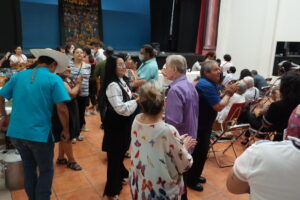
Durante la presentación, se amenizó con música en vivo y además hubo degustación de tamales, atole y ponche. Foto: Arturo Ortega.
Los escritos de Nicho se pueden comprar en su galería La Peña de Santos Rico, ubicada en la calle Constitución #16, en el centro del Pueblo Mágico.
Dionicio Morales, es un pintor y escritor de Ajijic, con dos libros publicados, y uno de los fundadores del Centro Cultural de la delegación.
Chronicles from La Ribera:
Curate Carlos Enrique Medina Garibaldo presides over the Palm Sunday procession in San Cristóbal Zapotitlán. Photo: María Reynozo.
By: María del Refugio Reynozo Medina
The women sweeping the square and the atrium of the temple of San Cristobal Zapotitlán announce the proximity of a celebration: the solemn mass of Palm Sunday.
A row of palm trunks are placed at the entrance of the temple, forming a path to reach the church. At the end, they carry a palm embedded in the center that rises towards the sky.
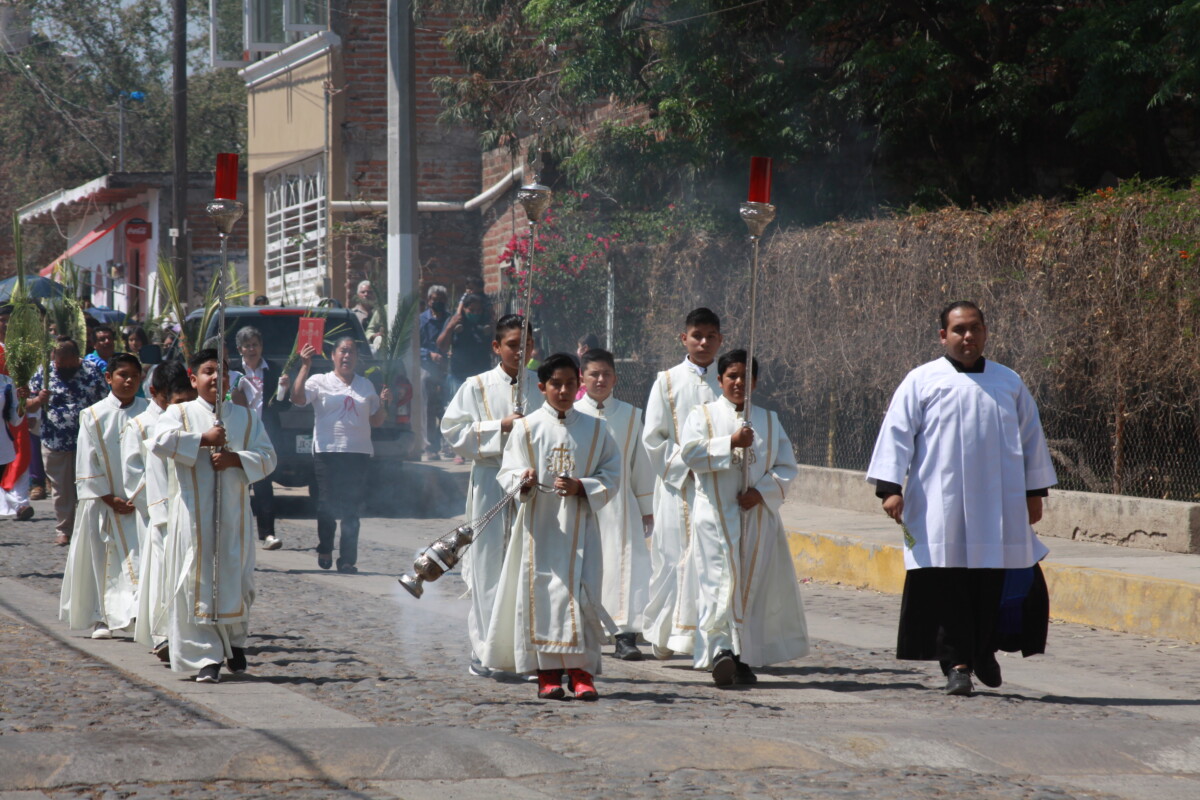
About a hundred parishioners participate walking led by the acolyte children. Photo: María Reynozo.
Two women sweep the scene, while in the square others pick up the garbage with the first rays of the sun shortly after eight in the morning.
Today, in addition to the Palm Sunday celebration, the 2022 recall election is taking place.
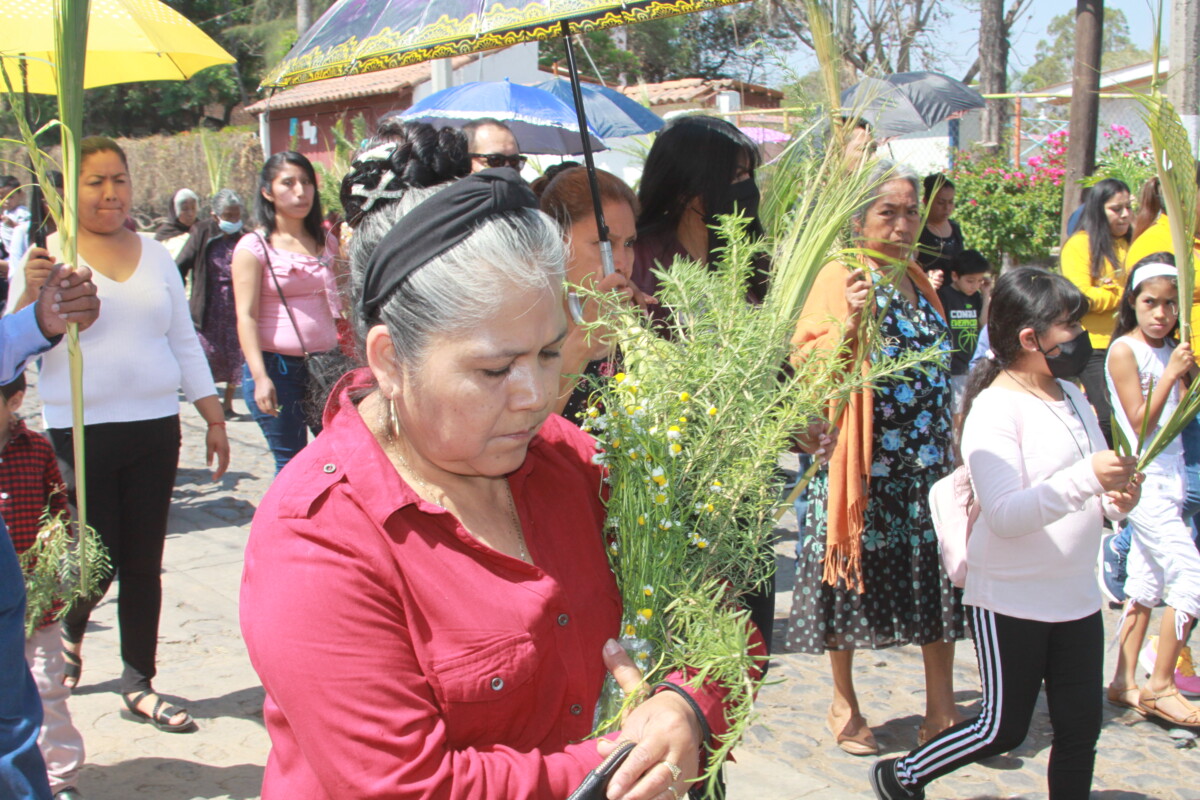
Chamomile and rosemary perfume the streets as the procession passes by. Photo: María Reynozo.
Around 11:30 a.m., parishioners congregate on Zaragoza Street in San Cristobal, near the crossroads. They carry bouquets of rosemary and chamomile. Some women carry babies in their arms; others in strollers.
A group of six people, four women and two men, carry light green braided palms, and two of them hold a bible in their hands as they advance in the procession.
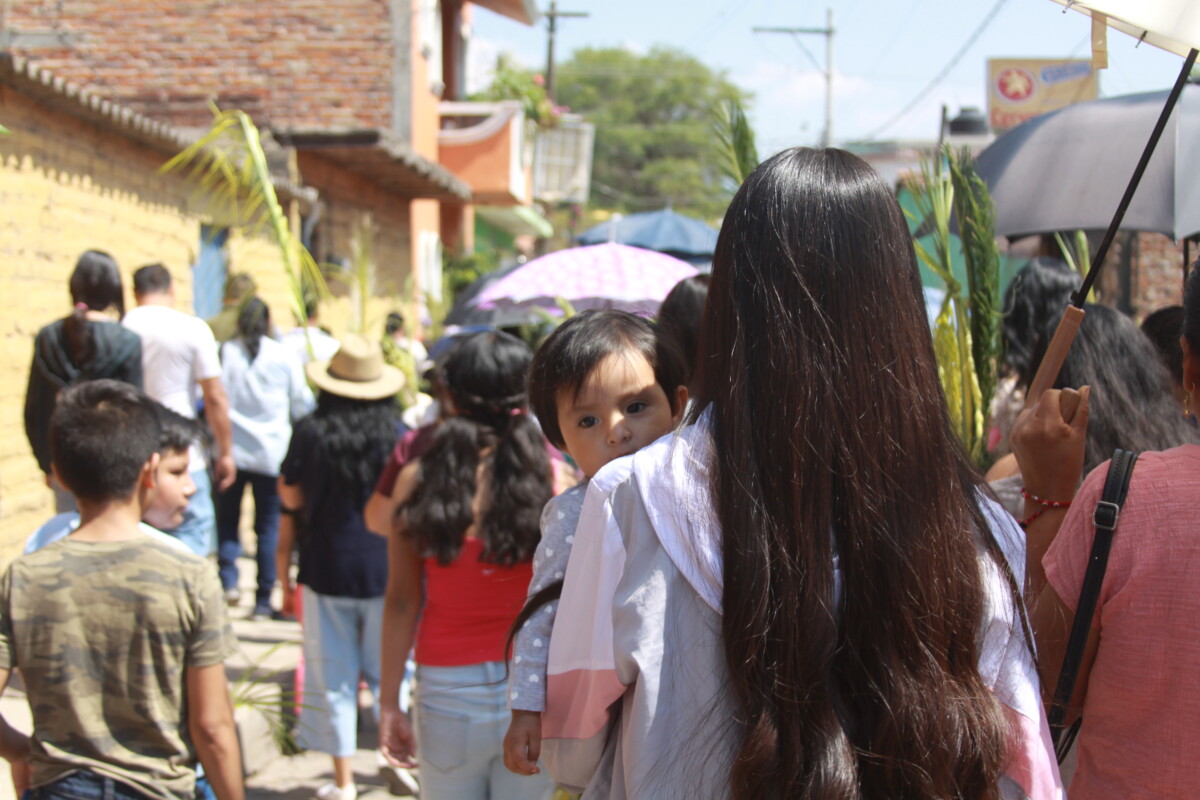
Children accompanying their parents participate in the procession. Photo: María Reynozo.
A group of men in bright robes characterize the apostles, while a young man in the role of Jesus Christ walks dressed in a white tunic and a red cloak. Cura Carlos Enrique Medina Garibaldo leads the procession that advances amidst chants and the aroma of copal.
The atmosphere smells of rosemary, basil and chamomile.
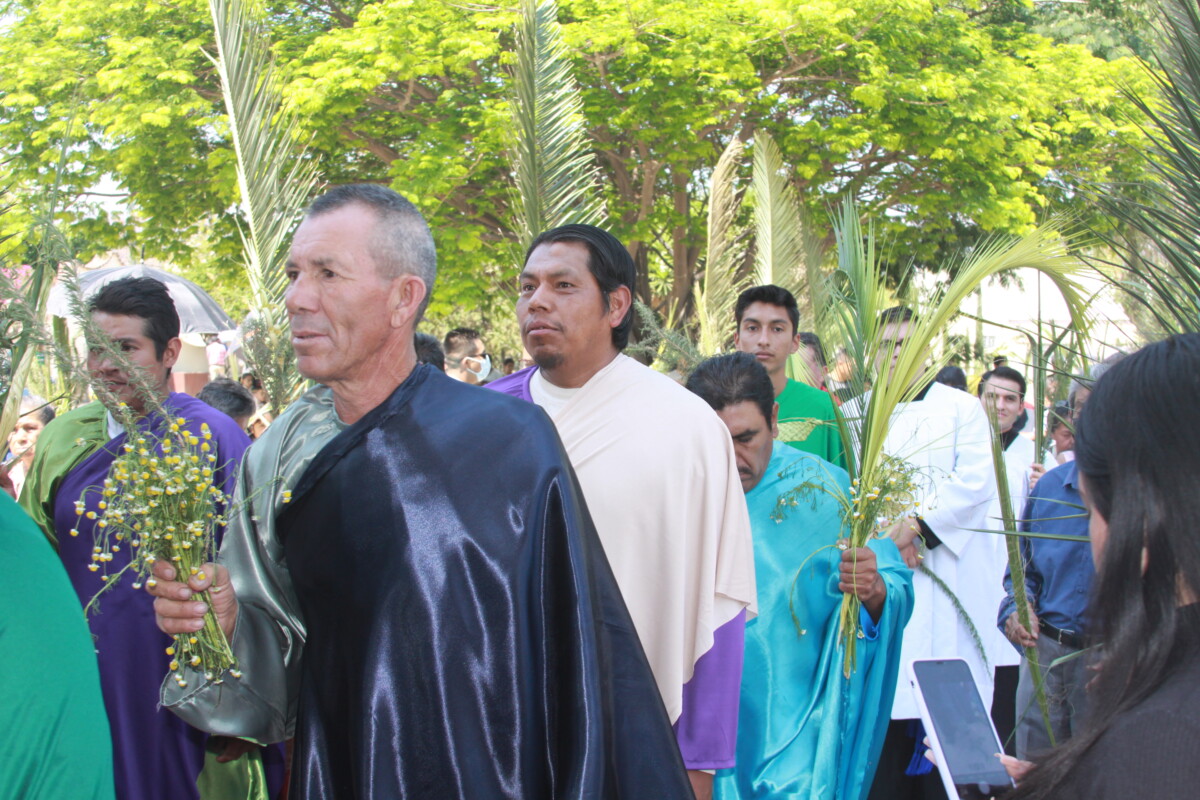
A group of men represent the apostles with their bright tunics. Photo: María Reynozo.
At the end of the celebration, people congregate in the plaza and many treat themselves to carnitas tacos, steak tacos or a slice of flan.
Meanwhile, in the premises a few meters from the elementary school, the ballot boxes are set up to carry out the recall referendum promoted by the President of Mexico, Andrés Manuel López Obrador (AMLO).
The polls opened at 8:00 a.m. and a few minutes later; however, at 8:30 a couple of the first voters appeared alone.
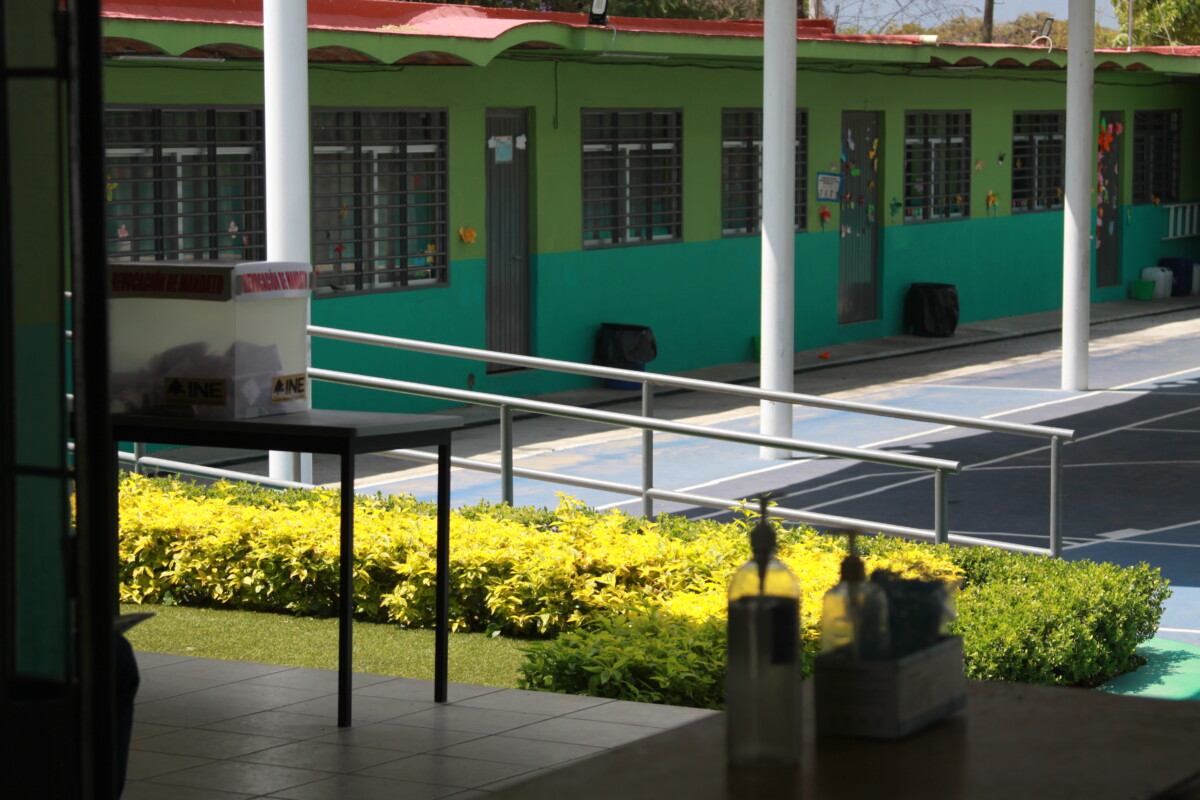
In the elementary school, the urns look lonely. Photo: María Reynozo.
Two polling places are installed; from section 1668 and 1687. Each polling place has a president, a secretary and a teller.
The arrival of voters is slow; and out of a voter roll of about three thousand, only 275 voters are present and the majority decision is for the incumbent president to remain.
This is how the announced recall process goes; between the bells that call to mass and the ballot boxes that call to vote where the fragrant rosemary bouquets exceeded by dozens the participation of the citizens.
Joel Salvador Torres Arrayga is the Jesus of the Passion of Christ Chapala 2022
Joel Salvador – Chapala. Torres Arrayga , who will portray Jesus in the Stations of the Cross and Passion of Christ Chapala 2022, next to Father Juan Manuel. Photo: Jazmín Stengel.
Jazmín Stengel.- Joel Salvador Torres Arrayga, originally from Chapala, was always devout and, although his work took him away from the ecclesiastical groups for a few years, he returned this year, to represent Christ during the Stations of the Cross and Passion of Christ Chapala 2022.
The 25-year-old was familiar with the Church throughout his life. Coming from a Catholic family, as a child he was an acolyte or altar boy in the parish of San Francisco de Asis. Years later, in his adolescence he was part of the Seminarians in Family (SemFam) group coordinated from the same parish, and during his high school years he was a member of the Salesian Missionary Group of Chapala.
This year, due to his long and curly hair, he was invited by the ‘Bola’ and Jesús Chávez to be part of the new group that re-enacts the Stations of the Cross and Passion of Christ in the municipal capital.
Translated by Patrick O’Heffernan
Holy Week begins with attendance of the faithful in San Juan Cosalá
The commemoration of Palm Sunday began with the traditional route from the Malecon (boardwalk) to the church of San Juan Cosalá. Photo: Alma Serrano.
Alma Serrano(San Juan Cosalá).- Catholics packed the atrium of the San Juan Bautista church in San Juan Cosalá to commemorate Palm Sunday at the beginning of Holy Week. The celebration began shortly before 8:00 a.m., when the faithful gathered on Del Cardenal Sur Street, next to where the Malecon (boardwalk) begins, to bless the palms.
Afterward, the procession began the journey to the church, emulating the triumphal entry of Jesus Christ into the city of Jerusalem and his confirmation as the son of God. Palm branches, prayers, faith, and emotion were the essence of the celebration in the community.
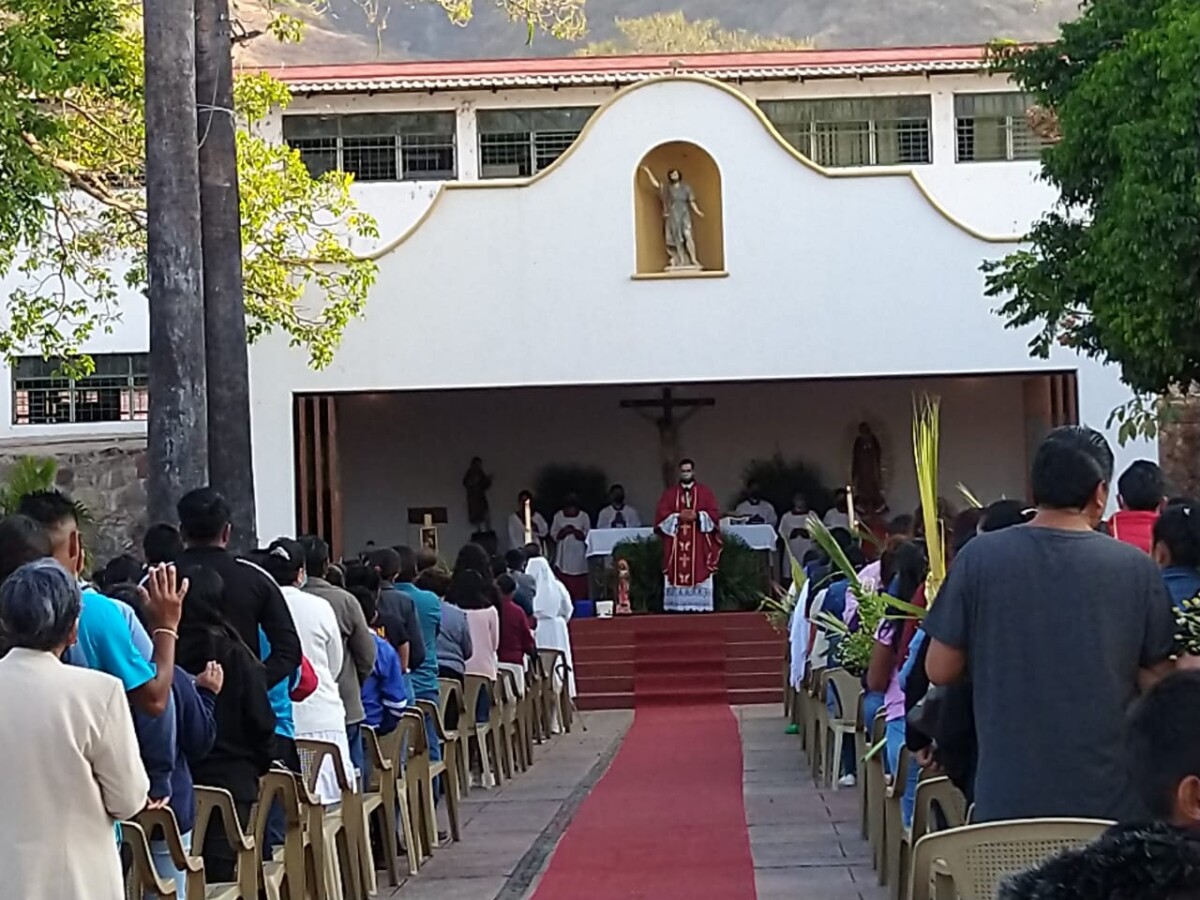
Approximately 400 people crowded the atrium of the Parish of San Juan Bautista. Photo: Alma Serrano.
This sacred act brought together around 400 people, who joined together to bid farewell to Lent and begin Holy Week, which lasts until Sunday, April 17, a time dedicated to remembering the passion, death, and resurrection of Jesus.
«These are not holidays, they are holy days, we need to meet again with the one who lost his dignity and take up our lives in the best way, let’s do the best with our lives because we only have one here on earth», said during the sermon the priest Ramón Ramírez López.
Also present at the ceremony, on both sides of the altar, were representatives of the 12 apostles. During the Eucharist, more than 70 people received communion, including children, young people, adults, and senior citizens, most of whom took appropriate sanitation measures.
Translated by Nita Rudy
Easter camping in Ajijic will have rules and timetable
On the beach at the end of Francisco Villa Street, some tarps can already be seen. Photo: Sofía Medeles.
Sofía Medeles . – This year, the residents of Francisco Villa Street have the permission of the delegation to carry out their traditional camping on the shore of the lake during Easter Week, from Thursday, April 14 to Sunday, April 17.
Acting Ajijic delegate Maximiano Macías Arceo said campers came to ask for permission, which was granted, although with some restrictions. For example, tents and tarps can be put up at the end of Francisco Villa Street and the beach of La Crucita.
In addition, the hours for listening to music will be limited. Although he did not mention an exact time, he said he does not want any problems with the neighbors who live near those beaches.
“It is not just for campers, but also any private home or business where they are exceeding the limit of both sound and hours,” Macías Arceo said. “If they do exceed the limits, public security will visit them to maintain order.”
Another topic he mentioned was the garbage generated. He asked for the cooperation of campers to keep the beaches as clean as possible. He said campers must remove their tents or palm leaf huts when their visit is over.
“On Easter Monday, April 18, they should no longer be there,” Macías Arceo said. “We trust they will be responsible and follow the restrictions.»
The tradition of camping on the shores of the lake during Holy Week began in 1992. Families go to the beach, set up their tents and stay on Holy Days – Thursday, Friday, Saturday and Sunday – to spend time with their neighbors.
Translated by Mike Rogers
Human Rights Commission asks Jocotepec to provide support to families of murdered police officers
The third general official of the Human Rights Commission (CEDHJ), Aldo Iván Reynoso Cervantes, informed that the Jocotepec City Hall has not responded to the communications that have been addressed to it.
Héctor Ruiz Mejía.– The Jocotepec City Hall has not yet clarified whether it has followed up on the proposals issued by the Jalisco State Human Rights Commission (CEDHJ), following the armed aggression that occurred on March 10.
More than a month after the attack that left two municipal police officers dead and two members of the Civil Protection and Fire Department injured, Aldo Iván Reynoso Cervantes, third inspector general of the CEDHJ, assured those various proposals were issued, to which there has been no response from the municipality.
Attached to the investigation folder issued by the same defense body with folio number 115/2022, proposals were made to support the indirect victims, who suffered harm by losing their loved ones.
This means, support in funeral expenses, settlement, compensation owed to them, as well as attention through health institutions, to provide psychological help and to conduct the mourning process.
Also, in the case of widows left behind in a precarious economic situation, to include them in social programs of the City Hall focused on people with basic needs or, failing that, if these are lacking, to try to channel them to the state DIF (social assistance program) to help those affected. The Jocotepec Council has voted to provide the widows of the slain officers with full pensions.
In the case of the direct victims, who suffered serious injuries in the course of their work, to provide full medical assistance as well as legal advice.
Although the exact deadline was not specified, Reynoso Cervantes said that the municipal government has so far ignored communications to clarify whether the proposals have been carried out and that they are days away from issuing the second warning.
«In the next few days, the term will expire, then we will see if we take it to a complaint or if the requirements were met to finish this investigation file,» said the third representative of the CEDHJ, who added that, in case of being ignored for the second time, it will be issued as a recommendation.
Translated by Nita Rudy
Local hero in Chapala cares for the altars of Dolores
Altar a la Virgen Dolorosa at Carlos Esparza Urzúa’s house, Miguel Martínez street, corner with 5 de Mayo.
Staff. – Mounting altars in honor of the Virgen de los Dolores is a tradition that has been waning over time at Lakeside; however, in the municipal capital of Chapala, a group of neighbors from the neighborhood of La Purísima, led by Carlos Ernesto Esparza Urzúa, keep the flame alive.
For 15 years now, Esparza Urzúa has been motivating his neighbors to make the altars. When it’s time to organize, «I ask and I tell them to do, and if they don’t want to do it, I’ll do it,» he exclaimed. With few or many members, he continues with the customs that his mother instilled in him.
In spite of the fact that other years the tradition was celebrated «in a big way,» with personifications of girls dressed in black and much more cooperation from neighbors from other streets, the participation was reduced during the pandemic.
This year, Esparza Urzua set up the main altar inside his house, on Miguel Martinez Street. The neighbors on 5 de Mayo Street supported him with three more. The group of ten people prayed a rosary at each altar and then, in accord with the tradition, asked, «Has the Virgin already cried?» In response, they received a glass of water, which represents the tears of the Virgin.
Carlos has kept images of the Virgin of Dolores for three generations, placed in the center of the altar, accompanied by a metal cross. His mother taught him to add a ladder representing the moment when Jesus returns to heaven, in addition to placing nails and hammer to represent objects used during the crucifixion.
The dice also symbolize the soldiers fighting for his tunic; the rooster that crowed when Peter, the apostle, denied Jesus three times; and white doves that represent peace.
Carlos Estrada Urzúa uses in his altar the colors purple and blue as a symbol of mourning, and regional plants such as clam, chamomile, birdseed and clover, the latter representing the Trinity.
In previous years the altars were kept up all night. However, security is no longer the same and things are stolen, said one of the neighbors, and as a result they dismantle their altars between 10:00 and midnight.
Finally, Carlos’ neighbors, who have grown as a family, will support him in setting up the Tended Christ outside his house, starting at 8:00 p.m. until the end of the March of Silence on April 15, Good Friday.
Translated by Sandy Britton
Llega nuevo cargamento de vacunas contra COVID-19 a Jalisco
Las vacunas recibidas corresponden a 111 mil dosis del laboratorio AstraZeneca. Foto: SSJ.
Redacción.- El lunes 18, Jalisco recibió el cargamento número 60 de vacunas, el cual consta de 111 mil dosis del laboratorio AstraZeneca que serán destinadas a los grupos de personas mayores de edad que no cuenten con ninguna vacuna, a quienes les falte su segunda dosis y para refuerzos.
Por lo tanto, la Secretaría de Salud Jalisco (SSJ) anunció que continuará la estrategia de aplicación de la vacuna en Centros de Salud cada vez más cerca de las personas, en sus trayectos al trabajo o sus hogares, asimismo para apoyar la operación del macromódulo habilitado en el Auditorio Benito Juárez que recibe a todas las personas sin necesidad de agendar cita.
Al encabezar la supervisión del arribo el secretario de Salud en Jalisco, Fernando Petersen Aranguren informó: “a la fecha hemos recibido ya 12 millones 551 mil 262 dosis de cinco diferentes laboratorios y aplicado más del 90 por ciento. Con la entrega de hoy continuamos la estrategia de vacunación en los centros de salud y en las unidades de instituciones federales como son el IMSS, el ISSSTE y la SEDENA. En conjunto, gracias a este apoyo, aún en medio de los días de asueto por Semana Santa, protegimos a casi 60 mil personas en Semana Santa”.
© 2016. Todos los derechos reservados. Semanario de la Ribera de Chapala
